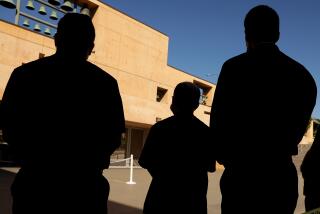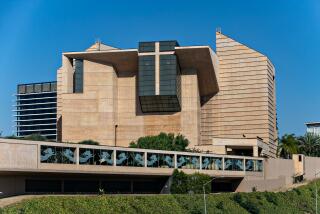Seminary’s ‘Terrible Truths’ Are Detailed : Religion: Franciscans are praised for dealing honestly with problems at now-closed school where 34 youths were molested.
- Share via
At first there was just one known victim. A pre-adolescent boy had been sexually molested by two Franciscan monks at St. Anthony’s Seminary in Santa Barbara.
Soon, anxious parents wondered if there were more. In October, 1992--several months after the first revelation--two men stood up at a public meeting and said that they, too, had been sexually abused as teen-agers at the seminary.
By the time an independent board of inquiry concluded its yearlong investigation this week, 34 boys were found to have been molested by 11 monks over a 23-year period ending in 1987, when the seminary closed for financial reasons. The provincial minister of the order publicly called the findings a “terrible truth” and “horrific.”
The investigation was notable for the number of abuse cases disclosed at one time, as well as for the Franciscans’ resolve to investigate known cases and flush out any still hidden.
“It has to be one of the most horrible things I’ve heard of yet that a substantial portion of a seminary faculty would be corrupted that way,” Father Andrew M. Greeley, a Catholic sociologist and outspoken critic of the church’s response to its sexual abuse crisis, said in an interview Tuesday.
Still, Greeley said he was impressed by the Franciscans’ response. “I can’t say the California Franciscans are the first ones to (respond so comprehensively), but I’m impressed by what they did,” Greeley said. “The Franciscans have been forthright and admirable in responding to it. I just wish that model was being followed everywhere.”
The panel found that the 34 cases of sexual abuse took place independently and that offending monks did not appear to be aware of each other’s activities.
One monk was responsible for abusing 18 of the 34 victims. Another monk abused seven. The abuse ranged from fondling and masturbation to oral copulation and sodomy, the panel said.
The Franciscans’ investigation was not universally applauded, however. A spokeswoman for a victims group said it was too little and too late.
Mary Staggs, founder of the Southern California chapter of the Survivors’ Network for Those Abused by Priests, complained that only two of the monks involved have been publicly named and only one has been prosecuted.
“This only fosters further secrecy of abuse,” she said. “These men should have been turned over to law enforcement immediately.”
However, under the statute of limitations, it appears that none of the priests can be prosecuted, although they may still be liable if civil cases are filed against them.
The bishops, meeting in Washington earlier this month, also called on the Vatican to lengthen the statute of limitations for prosecuting errant priests under church law. Greeley has estimated that at least 2,500 priests nationwide have victimized 100,000 children in the past 20 years.
Still, by appointing an independent body, providing counseling and pastoral care for the victims and their families, and by removing the perpetrators from contact with young people, the Franciscans appear to have gone a long way toward practicing what the nation’s Roman Catholic bishops are increasingly urging.
That, however, has not removed the stain of the latest scandal or the damage to victims.
One of the victims told The Times on Tuesday that a priest sexually molested him when he was a freshman at the seminary.
“I was uncomfortable, humiliated, and didn’t understand what was happening,” said John McCord, now 37 and a businessman in Northern California. He said his teacher reassured him that fondling and molestation were not inappropriate. “I was raised to never question the church, the priests or anybody in authority,” he said.
But after he was married, the secret became unbearable. “I started cracking up,” he said. He sought counseling and last year wrote a letter to his molester and to the provincial minister in Santa Barbara.
At the same time, the board of inquiry--which included a lawyer, three psychotherapists, a member of the order and a parent--was beginning its investigation.
As the probe unfolded, two among the many involved in the inquiry said they were shocked by the extent of the abuse.
“It was very difficult. I’d gone to (St. Anthony’s) seminary myself in the late 1950s and early 1960s. I had an emotional attachment,” said Father Joseph Chinnici, the provincial minister. “I was in a position on one hand to try to support the friars who felt betrayed by their own and also to discipline others I had known whose behavior--hidden up till then--was becoming manifest to me.”
Meanwhile, the attorney who headed the board of inquiry, Geoffrey Stearns, said he was surprised at his emotional reaction to the 34 cases, even though he expected more allegations to surface.
“I guess I had a sense there was definitely more there. It was just a hunch. I had a feeling,” Stearns said Tuesday. “For a long time we were so busy just trying to keep organized and keep things straight and to make sure we didn’t lose any data. But there was a time when I just sat down and read over that statistical section. That was very powerful. I kind of felt like I’d been punched. I guess that’s when it kind of hit home.”
Of the 11 priests involved, eight were being treated by therapists, one has died, another’s case is still being investigated and one has left the order.
The first allegation was made by a former member of the Santa Barbara Boys Choir, which was founded by Father Robert Van Handel, former rector of St. Anthony’s. When that case became public, Chinnici sent letters to all choir members’ parents seeking more information and offering help. The choir was nondenominational and not affiliated with the seminary.
Later, at the urging of parents, similar letters were sent to 900 parents of seminarians at St. Anthony’s. The letter asked for any information about inappropriate sexual behavior toward students by any member of the faculty.
Finally, the independent six-member board of inquiry was established. During the last year, the panel heard from victims and their families as well as from others concerned. Offending priests were also invited to appear, but none did. The names of suspected abusers were promptly forwarded to Chinnici, who immediately interviewed them and referred them for counseling, reassignment and treatment.
“I said if we’re going to do this we want to do it thoroughly, competently, and we want to do it once. We want to try to root out the historic problem once and for all,” Chinnici said Tuesday.
So far, he said, about $90,000 has been spent on psychological counseling for victims and their families. The monks are also getting psychological help. Their ministerial activities are severely restricted.
“They also are our brothers and we want to treat them that way. At the same time we recognize the severity of the issue, the necessity of discipline, and the methods and processes are in place to assure a risk-free situation in terms of ministry and placement,” Chinnici said.
Candidates for the order must undergo a screening process incorporating psychological testing under a policy established several years ago, Chinnici said. Since 1989, the province has had a policy on sexual abuse of minors and on friar misconduct. Workshops have also been held on mandatory child abuse reporting.
Chinnici said the board of inquiry’s work will be carried on by a permanent province-wide assessment team to be named in January.
“I think in the long run the (findings) will be seen as making a positive and constructive contribution to a problem that not only the church but society itself is facing,” Chinnici said.
Times special correspondent Kathleen Sharp in Santa Barbara contributed to this story.
More to Read
Sign up for Essential California
The most important California stories and recommendations in your inbox every morning.
You may occasionally receive promotional content from the Los Angeles Times.










